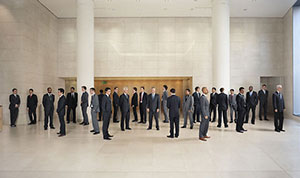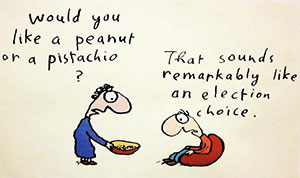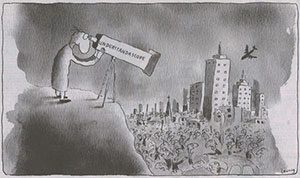Australian advertising entrepreneur John Singleton described election campaigns as the “ultimate one day sale”. This ought not be considered an endorsement.
Arguments in favour of political advertising centre on the theme that it provides voter information and is a form of freedom of speech.
A contrary view suggests that it provides little in the way of information, and that financial limits on freedom of speech already exist in the form of media ownership laws – which set a precedent that we are willing to limit ‘freedom’ where financial power can be used to stifle diversity of opinion.
The financial dominance of advertised opinion by the two major parties (through public financing) is comparatively recent in Australia. The Hawke Labor government introduced public funding of election campaigns in 1984 – after the two major parties spent $12m on campaigns but failed to secure an equivalent amount from private donors (see Sally Young, “The Persuaders” for further detail).
For a short period in 1991, paid political advertising on television was banned by legislation, however the legislation was struck down in the High Court on the basis that the Constitution contained an implicit freedom of political communication. Further history on this point is contained in the Further Readings below which links to a relevant Parliamentary Library Brief.
In 1995, the parties agreed to double the amount of public funding, resulting in a surge of spending ($30m for the 1996 election compared with $12m in 1984). The value of political parties as significant clients of major media outlets also creates a public distrust even though no impropriety of leveraging this expenditure in return for more favourable comment has been identified. However, a healthy democracy relies as much on the perception of honesty, as it does on honesty itself.
The weight of money in the system has now increased to $80m being spent in the 2007 election and approximately $95m being spent during the 2010 election. A substantial component of this is paid for by the public purse from the primary vote re—imbursement. As such, a requirement not to use this public funding on advertising would have a dramatic effect.
The book ‘The Persuaders’ (detailed in the further readings below) suggests reinstating disclosure requirements on party spending of public funding, and restricting how parties can use public funding. Further options include legislating for free air time for candidates as part of commercial TV license requirements, which would then be distributed to candidates by the Australian Electoral Commission.
The importance of this advertising limitation is primarily the barrier to entry this creates to new entrants in the market for political ideas, resulting in a system that is less representative. (Research opportunities here will also explore the impact of an introduction of Trade Practices Act compliance, detailed further here).
Advantages of these Reforms
The core advantage is to level the playing field by reducing an inequity that gives a disproportionate share of voice to the established parties courtesy of taxpayer funding. The current weight of political advertising contributes to the heightened adversarial tone and the limits on representative diversity, so a regulatory change should have a positive effect.
Arguments Against these Reforms
“Limiting advertising is limiting freedom of speech.”
Two points stand out here. Firstly, freedom of speech may be thought to refer to one’s ability to express a public view without fear of imprisonment or persecution. These reforms clearly do not come in conflict with that definition. It is, however, an attempt to limit a party’s ability to repeat some speech thousands of times and in so doing drown out competitive voices.
Secondly, we already curtail freedom of speech where this is judged to be in the public interest – from media ownership laws to the public safety test of not yelling “fire” in a crowded theatre.
John Stuart Mill observed that “Democracy only works when you have an informed citizenry at its core” – the key question is whether political advertising informs or whether it manipulates. This question can only be judged by the citizens themselves as part of the reform process.
A further freedom of speech argument to be explored regards implementation: this would require a ban on paid (advertised) advocacy by any organisation for a 60-90 day period prior to an election in order to avoid its circumvention.
Background and Origins
Commentary on political advertising has been expansive both in Australia and internationally. Within Australia, the most comprehensive (and among the earliest) was produced by Sally Young.
Questions for Further Study
What is an appropriate level at which to cap advertising?
If the Australian Electoral Commission is to distribute advertising, then what is the criteria for being able to access this public resource?
What is an appropriate window of time prior to an election during which any limitation on political advertising would apply?
What You Can Do
No organisation continues to do something which annoys its core customers. However, it is viewed that advertising serves an overall net positive to the parties’ electoral prospects or they would not do it. That is, the net number of votes acquired is positive.
Advertising spending is an arms race that either party would likely gladly give up as long as they could be sure that no loophole had been left to give their opponent an opportunity which would be denied to them. As such, this is a policy area uniquely suited to balance of power candidates in the lower and/ or upper houses. We would suggest that you send them a letter. No, we haven’t written that letter, as we remain hopeful that when 1,000 identical form letters reach an MP they at least realise it’s a campaign. We trust you to state why you would like to see this reform in your own words. If you would like some help, email us
Clarifications
None yet requested.
Further Readings
- Young, S. The Persuaders, Pluto Press Australia, 2004. Buy it online (Free Shipping Worldwide)
- Franz, M.M. [et al.]. Campaign Advertising and American Democracy Temple University Press, 2007. Buy it online (Free Shipping Worldwide)
- Miskin, S. & Grant, R. Parliamentary Library Research Brief no. 5 2004–05 http://www.aph.gov.au/library/pubs/rb/2004-05/05rb05.htm#bans
 Image credit: Mitra Tabrizian ‘City London’ 2008
Image credit: Mitra Tabrizian ‘City London’ 2008




